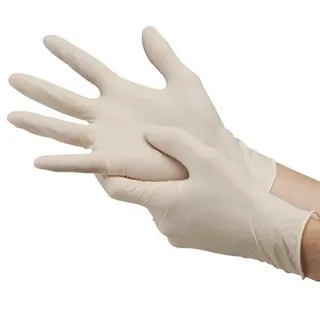Latex-gloves have been a staple in various industries for decades, providing essential protection and comfort for users. Whether in medical settings, industrial environments, or everyday tasks, the versatility of latex-gloves makes them a popular choice for many. In this blog post, we will explore the benefits of premium latex gloves and their importance in different fields. From their unmatched durability to their superior protection, discover why latex-gloves are a top choice for professionals and consumers alike.
Understanding the Basics of Latex-gloves
Latex-gloves, crafted from the sap of rubber trees, are celebrated for their remarkable flexibility and resilience. This natural material endows the gloves with exceptional stretch ability, ensuring they can be snugly fitted to the contours of the wearer’s hands without compromising comfort. Their intrinsic strength renders them resistant to perforations and abrasions, offering reliable hand protection in various settings. Such gloves excel in transmitting sensations, allowing for tactile precision in tasks that demand meticulous attention to detail.
The Unmatched Benefits of Premium Latex-gloves
Premium latex-gloves stand out for their enhanced qualities, which are tailored to meet the demands of users seeking more than just basic protection. These gloves are meticulously manufactured from top-tier latex, ensuring they surpass the standard performance metrics in terms of durability and resilience. The rigorous testing these gloves undergo is a testament to their reliability in high-stakes environments, where failure is not an option.
One of the hallmark features of premium latex-gloves is their exceptional comfort. Engineered for prolonged wear, they minimize the discomfort and fatigue commonly associated with extended use, thanks to their superior ergonomic design and material composition. This makes them an indispensable asset in professions requiring long hours of glove use, where comfort can significantly impact productivity and efficiency.
Moreover, the protective barrier offered by these gloves is second to none. They provide an enhanced defense against pathogens, chemicals, and physical threats, making them a safeguard in scenarios where exposure risks are high. Their tactile sensitivity is preserved, ensuring that users can perform tasks requiring precision without hindrance.
Latex-gloves in the Medical Field: A Critical Review
In healthcare environments, the significance of latex-gloves transcends mere protection. They serve as a fundamental barrier between medical practitioners and the myriad of exposures to infectious agents. The adoption of premium latex-gloves within these settings is driven by their unparalleled barrier efficacy and tactile sensitivity, which are imperative for executing intricate medical procedures with precision. Such gloves are instrumental in surgical rooms, laboratories, and patient care, where their robust defense mechanism against pathogens ensures a sterile field is maintained.
The preference for premium varieties in the healthcare sector is also underscored by their heightened resistance to the rigors of repeated donning and removal, a common practice in medical routines. This durability reduces the risk of glove failure, a critical factor when patient and practitioner safety is at stake. Additionally, the comfort afforded by premium latex-gloves mitigates the risk of hand fatigue during lengthy surgeries or examinations, thus safeguarding the welfare of healthcare professionals.
It is, however, imperative to acknowledge the specter of latex allergies within clinical settings. The selection of latex-gloves necessitates a balanced consideration of protective benefits against the potential for allergic reactions among healthcare staff and patients. Consequently, the medical community continues to advocate for awareness and the provision of alternative glove materials to accommodate sensitivities, ensuring that the deployment of latex-gloves remains both a safe and effective practice in patient care.
Industrial Applications of Latex-gloves
In the realm of industry, the adoption of premium latex-gloves is instrumental in safeguarding workers from a myriad of occupational hazards. These environments often present challenges such as exposure to harmful chemicals, the handling of sharp implements, and interaction with abrasive materials, necessitating robust hand protection. Premium latex-gloves are particularly esteemed in these settings for their superior puncture and tear resistance. This resilience is critical in sectors like manufacturing, where the manipulation of machinery and tools is routine, and in construction, where hands are frequently exposed to potential injury.
The gloves’ dexterity and tactile sensitivity are also crucial, enabling workers to perform precision tasks without compromise. Moreover, their adaptability to diverse industrial needs—from automotive repair to chemical processing—underscores their indispensability. The choice of premium latex-gloves in these contexts reflects a commitment to not only worker safety but also to maintaining operational efficiency and product integrity.
Everyday Uses for latex disposable gloves
Latex disposable gloves find their utility far beyond the confines of professional environments, becoming a staple in daily life for a myriad of practical reasons. In the domestic sphere, these gloves are indispensable for a variety of chores, from the rigorous scrubbing of bathrooms to the meticulous cleaning of kitchens. They act as a protective barrier, preventing the transfer of germs and shielding hands from the harsh effects of cleaning agents. The culinary realm, too, benefits from the use of latex-gloves. They ensure hygienic food handling, effectively minimizing the risk of cross-contamination when preparing meals or when handling raw ingredients such as meat and fish.
Gardening enthusiasts also turn to latex-gloves for protection against soil, pests, and thorns, thereby keeping their hands clean and safe from potential irritants. Additionally, for those who dabble in arts and crafts, these gloves can be a boon, protecting skin from stains, adhesives, and other materials that are tough to wash off.
Given their versatility, premium latex-gloves, with their enhanced durability and comfort, are particularly suited for these everyday tasks. They provide not just a safeguard against dirt and germs but also ensure that tasks are performed comfortably and efficiently, without the worry of gloves tearing or causing discomfort. This makes them an essential item in any household, simplifying routine tasks and promoting a hygienic lifestyle.
 How to Choose the Right Latex-gloves?
How to Choose the Right Latex-gloves?
Selecting the ideal pair of latex-gloves necessitates a thoughtful consideration of several key aspects to ensure they meet your specific requirements. Firstly, the size of the gloves is paramount. Gloves that are too tight can restrict movement and cause discomfort, while overly loose gloves may compromise dexterity and functionality. Therefore, it is vital to consult sizing charts provided by manufacturers to find the perfect fit.
Thickness is another crucial factor; thicker gloves offer better protection against chemicals and punctures, making them suitable for high-risk environments. Conversely, thinner gloves provide superior tactile sensitivity, beneficial for tasks requiring precision.
The intended use of the gloves should guide your choice. For instance, medical-grade gloves are essential for healthcare settings to ensure they meet rigorous safety standards. In contrast, for household tasks or food handling, standard latex-gloves may suffice.
Ultimately, your selection should reflect a balance between comfort, functionality, and safety, ensuring the gloves enhance your ability to perform tasks effectively without compromising on protection.
Understanding and Managing Latex Allergies
Latex allergies pose a significant concern for a subset of individuals, potentially triggering reactions ranging from skin irritations to anaphylaxis. Recognizing the signs of latex sensitivity is pivotal, including symptoms such as itching, redness, and swelling upon contact with latex products. For those diagnosed with a latex allergy, it is essential to adopt proactive measures to minimize exposure. This includes opting for alternative materials like nitrile or vinyl which provide similar protective qualities without the associated risk. Moreover, awareness within workplaces and medical settings is crucial to ensure a safe environment for everyone.
Precautions, such as clear labeling of latex-containing products and readily available information on alternatives, can greatly mitigate the risk of allergic reactions. Regular consultation with healthcare professionals can also offer guidance on managing allergies and selecting appropriate non-latex options for personal or professional use. Ultimately, understanding one’s sensitivity and adopting suitable precautions can significantly reduce the adverse impacts of latex allergies.
The Future of Latex-gloves: Innovations and Sustainability
The trajectory of latex-gloves is heading towards a horizon where innovation intersects with eco-consciousness. Researchers and manufacturers are dedicating efforts to refine the ecological footprint of these ubiquitous products. A significant focus is on devising methods to produce latex-gloves that are not only derived from renewable resources but also exhibit enhanced biodegradability. This shift is in response to the growing environmental concerns associated with disposable gloves, which traditionally contribute to landfill mass.
Advancements in material science have opened avenues for developing latex-gloves with improved durability and reduced thickness, without compromising on their protective qualities. Such innovations promise to reduce material use and waste while maintaining, if not enhancing, the gloves’ performance. Moreover, the industry is exploring alternatives to traditional rubber tree latex that could potentially lower allergic reactions, thereby marrying the dual objectives of sustainability and user safety.
These alternatives include materials that mimic the beneficial properties of latex—such as elasticity and resistance to tears—while being more environmentally friendly and hypoallergenic. Collaborations across sectors are fostering the development of recycling programs, aiming to repurpose used latex-gloves in a bid to further mitigate their environmental impact. Through these concerted efforts, the future of latex-gloves is set to redefine standards of protection, comfort, and, crucially, sustainability, ensuring their place in both professional and everyday contexts for years to come.
Conclusion
Latex gloves, particularly those of premium quality, are essential allies in a variety of activities. They embody a perfect combination of durability, tactile sensitivity, and user comfort, making them the preferred option for professionals and homeowners alike. Exploring the nuances of latex-gloves reveals their unparalleled role in ensuring safety and hygiene, whether during complex medical procedures, demanding industrial operations, or daily tasks. The selection process, which takes into account factors such as size, thickness, and specific use, helps individuals make choices that meet their unique needs. Embracing these aspects allows us to appreciate the true value and versatility of latex-gloves in promoting a safer and more efficient environment in various settings.
FAQS
Q: Can I reuse latex gloves?
A: Generally, latex gloves designed for single use should not be reused, especially in medical or food handling settings, due to the risk of contamination. Reusable latex-gloves are available for non-disposable tasks but should be cleaned according to the manufacturer’s instructions.
Q: How can I tell if I’m allergic to latex-gloves?
A: Symptoms of a latex allergy can include itching, redness, swelling, or a rash on the skin after contact with latex products. If you suspect an allergy, it’s advisable to consult a healthcare professional for testing and guidance on alternative materials.
Q: Are latex-gloves biodegradable?
A: Latex-gloves are made from natural rubber, which is biodegradable. However, the process can take a long time, and environmental conditions affect the rate of degradation. Efforts are ongoing to improve the eco-friendliness of these products.
Q: How do I choose the right size of latex-gloves?
A: Most brands offer a sizing chart. It’s important to measure your hand and refer to these charts to ensure a snug, comfortable fit that does not compromise dexterity or protection.
Q: What’s the difference between powdered and powder-free latex-gloves?
A: Powdered gloves have cornstarch or similar substances inside to make them easier to put on, especially if your hands are damp. Powder-free gloves undergo a process to remove this powder, reducing the risk of allergic reactions or contamination.
| Other Good Articles to Read |
| Skank Blogs |
| Unreal Blogs |
| Tba Blogs |
| All City Forums |
| Dany Blogs |
| Refuge Blogs |
| The Music Blogs |
| Key Forums |
| The Big Blog Theory |
| Joe Blogs |
| Blogs 4 Me |
| Blogs Emon |
| Related Business Listings |
| Contact Directory |
| Local Business Profiles |

